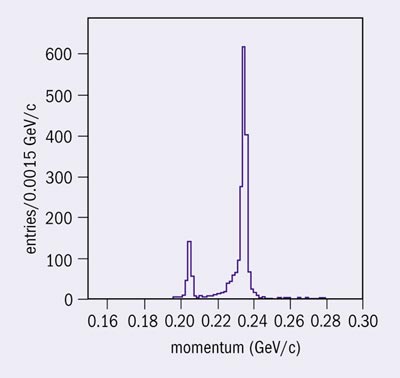The first results from the FINUDA experiment at INFN’s Frascati National Laboratory show that the detector is performing well and is in good shape for its future studies of hypernuclear physics. At the XLII International Winter Meeting on Nuclear Physics in Bormio, Italy, at the end of January, the FINUDA team presented data on the performance of the detector, as well as preliminary observations of the formation of hypernuclei and their decay spectra.

The FINUDA detector was installed at the DAFNE “φ factory” in Frascati in the spring of 2003. The experiment makes use of the low-energy negative kaons emitted in the decays of the φ particles created in DAFNE. The decays produce an almost monochromatic beam of K– with an energy of about 16 MeV. These low-energy K– can come to a stop in thin targets and interact with nuclei via a strangeness-exchange reaction, where the strangeness of the kaon is transferred to a nucleus in which a neutron (containing udd quarks) becomes a lambda particle (uds).
The use of thin targets means that the FINUDA experiment can make the most of its intrinsic momentum resolution in order to provide high-resolution measurements of hypernuclear energy levels. In addition, the apparatus is designed to detect charged and neutral particles with large angular coverage and high statistics. The experiment can also measure spectra from different targets at the same time, so reducing the number of possible systematic errors.

Once the commissioning of FINUDA was complete in October 2003, data taking could begin with a set of targets of different nuclei – 6Li, 7Li, 12C, 27Al and 51V – that were chosen to allow a variety of simultaneous studies of the formation and decay of hypernuclei. The targets form an octagon surrounding the interaction region, where the K– are produced in the decay of φ particles to K+K– pairs. Within the target array, thin slabs of scintillator detect the highly ionizing low-energy kaons. Hypernuclear-formation events are selected by a trigger that picks out K+K– pairs accompanied by a fast particle (a pion) coming from the interaction of the K– in a target (see figure 1).
The data collected so far indicate a momentum resolution, Δp/p of 1.1% full width at half maximum (FWHM), corresponding to a resolution of approximately 2.5 MeV on hypernuclear energy levels (see figure 2). This value should improve after final calibration and detector alignment. The indications are that during its first phase of data taking FINUDA should collect about 105 useful events per target – which is enough for some high-resolution spectroscopy on the various nuclei.
Further reading
M Agnello et al. 2003 Frascati preprint LNF-03/23(P); to appear in Nucl. Phys. B (Proc. Suppl.).





